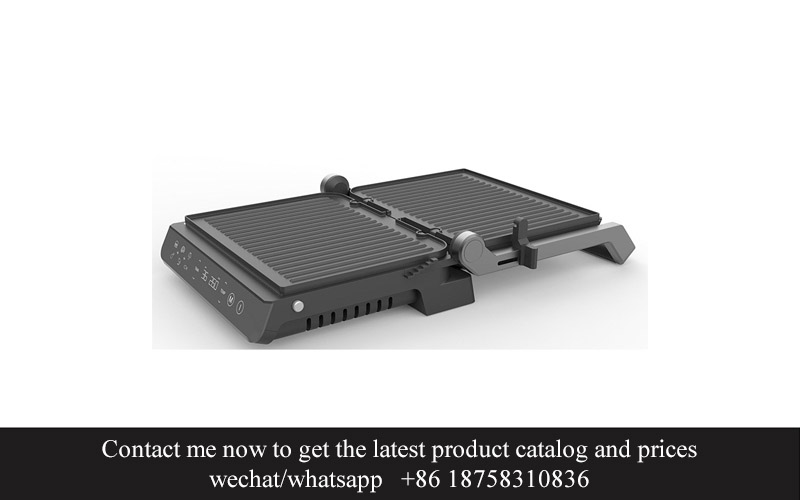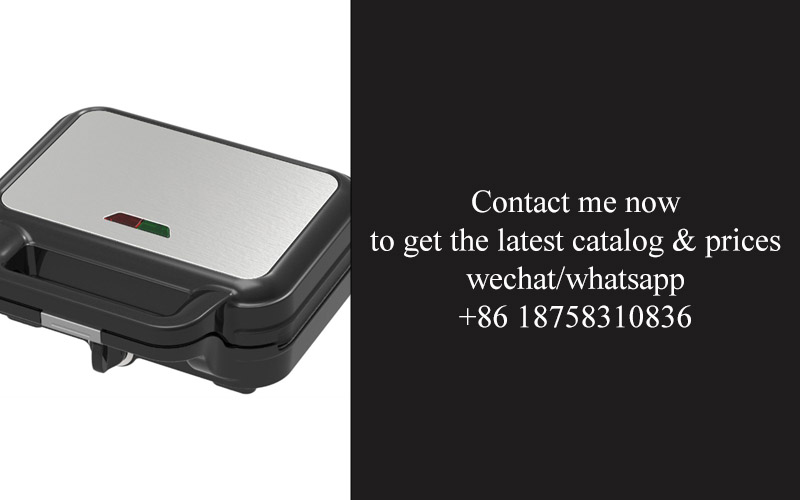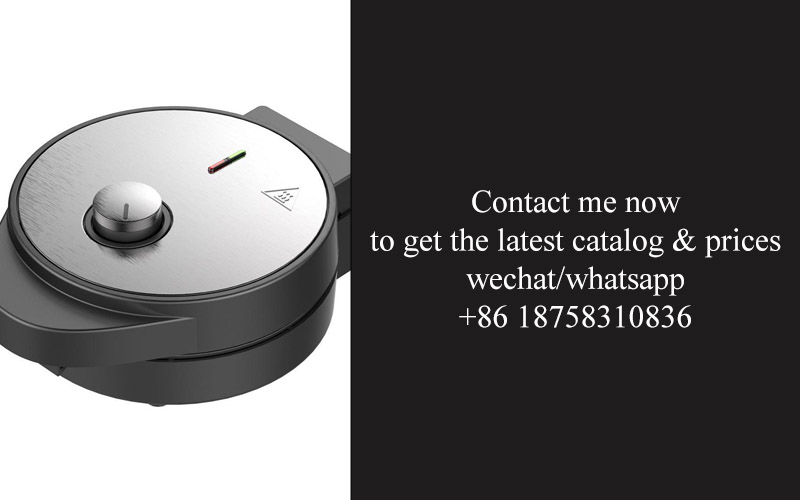Address
304 North Cardinal
St. Dorchester Center, MA 02124
Work Hours
Monday to Friday: 7AM - 7PM
Weekend: 10AM - 5PM
Address
304 North Cardinal
St. Dorchester Center, MA 02124
Work Hours
Monday to Friday: 7AM - 7PM
Weekend: 10AM - 5PM

In the ever-evolving world of culinary innovation, the sandwich grill has emerged as a game-changer, blending the simplicity of a fast-food staple with the artistry of cooking. As technology advances, so does the way we savor our meals, and the continuous operation sandwich grill plant is at the forefront of this revolution. This piece delves into the intricacies of the market dynamics, the innovative features shaping the technology, and the promising future it holds for the sandwich industry.
The continuous operation sandwich grill plant has emerged as a game-changer in the culinary landscape, offering a seamless and efficient solution for fast-food establishments and commercial kitchens alike. These innovative cooking stations are designed to operate without pause, providing a steady stream of freshly grilled sandwiches to satisfy the growing demand for quick-service meals.
These plants are a testament to the evolving culinary industry, where speed and quality are no longer mutually exclusive. The rise of continuous operation sandwich grill plants can be attributed to several factors. Firstly, the increasing popularity of fast-casual dining has created a market where speed is king. Customers are looking for quick meals that don’t compromise on taste or freshness.
Secondly, the advancements in technology have allowed for the creation of high-capacity, low-maintenance grill systems. These systems are engineered to handle a constant flow of ingredients, ensuring that the output remains consistent and reliable. The integration of automated processes has reduced the need for manual labor, making these plants a cost-effective solution for businesses looking to streamline their operations.
The design of these sandwich grill plants is both functional and innovative. They are equipped with multiple grill units that can handle various types of sandwiches, from classic ham and cheese to gourmet creations with exotic fillings. The modular design allows for easy expansion and customization, ensuring that each plant can be tailored to the specific needs of the business.
One of the standout features of these continuous operation sandwich grill plants is their ability to maintain a high level of hygiene. With automated cleaning systems and easy-to-access components, these plants are designed to prevent cross-contamination and ensure that every sandwich is cooked to perfection. This focus on cleanliness is particularly important in the food service industry, where health codes and customer satisfaction are paramount.
The efficiency of these plants is not just limited to their ability to produce sandwiches at a rapid pace. They are also designed to minimize waste and energy consumption. Advanced sensors and controls ensure that the grills operate at optimal temperatures, reducing the risk of burning or undercooking. Additionally, the use of energy-efficient lighting and heating systems helps to lower the overall operational costs.
The market for continuous operation sandwich grill plants is expanding rapidly. Fast-food chains, cafes, and food trucks are all recognizing the benefits of these innovative cooking stations. In fact, many are opting to replace traditional grills with these state-of-the-art systems to enhance their menu offerings and appeal to a more discerning clientele.
One of the key advantages of these plants is their scalability. Whether a business is a small local café or a large international chain, there is a model that can meet their needs. This flexibility has made continuous operation sandwich grill plants a popular choice across a wide range of industries.
Moreover, the trend towards healthier eating habits has also played a role in the growth of this market. As consumers become more health-conscious, they are seeking out options that offer fresh, unprocessed ingredients. Continuous operation sandwich grill plants provide a perfect platform for creating custom-made sandwiches that cater to these dietary preferences.
The integration of technology into the food service industry has not only revolutionized the way sandwiches are cooked but also how they are marketed. Social media and digital platforms are being used to showcase the capabilities of these sandwich grill plants, highlighting their speed, efficiency, and the high-quality products they produce.
In conclusion, the rise of continuous operation sandwich grill plants is a clear indication of the industry’s commitment to innovation and customer satisfaction. These plants are not just a trend; they are a fundamental shift in how we think about fast-food preparation. As the demand for quick, healthy, and delicious meals continues to grow, these sandwich grill plants are poised to become an integral part of the culinary landscape.

In the bustling landscape of the foodservice industry, the rise of continuous operation sandwich grill plants has been nothing short of a game-changer. To truly grasp the market dynamics at play, one must delve into the intricate web of consumer demand, technological advancements, and competitive strategies.
Consumer preferences have evolved dramatically, with a growing emphasis on convenience, speed, and quality. This shift has pushed sandwich grill plants to adapt and innovate, offering solutions that cater to the fast-paced lifestyle of modern diners. The demand for quick-service options has surged, leading to a surge in the popularity of continuous operation grills, which can churn out sandwiches at a rapid pace without compromising on taste.
The competition within the market is fierce, with a myriad of players vying for market share. From established foodservice giants to niche startups, each is striving to offer unique features and advantages that set their products apart. This competition has spurred a constant stream of innovation, with manufacturers pushing the boundaries of what a sandwich grill can do.
One key factor influencing market dynamics is the rise of health consciousness among consumers. With a growing number of people looking for balanced, nutritious meals, sandwich grill plants are responding by offering a variety of options, including high-protein, whole-grain, and low-carb sandwiches. This health-conscious approach not only appeals to a broader audience but also positions these grills as a versatile tool for a diverse range of culinary creations.
Technology has also played a pivotal role in shaping the market dynamics. The integration of smart features, such as touchless operation, self-cleaning systems, and digital temperature controls, has made sandwich grills more user-friendly and efficient. These technological advancements not only enhance the operational experience but also reduce downtime, ensuring a seamless workflow in busy kitchens.
Distribution channels have expanded, offering multiple entry points for sandwich grill manufacturers. From direct sales to partnerships with equipment suppliers, the variety of distribution methods allows for targeted marketing and a wider reach. Additionally, the rise of e-commerce has opened up new avenues for direct-to-consumer sales, enabling manufacturers to tap into the online market and cater to a global customer base.
Regulatory changes and safety standards also play a significant role in the market dynamics. As health codes and safety regulations evolve, sandwich grill plants must ensure their products comply with these requirements. This often means incorporating new materials, design features, and manufacturing processes to meet the latest industry standards.
The global landscape of the market dynamics is also shaped by economic factors. Fluctuations in the cost of raw materials, such as meat and bread, can impact pricing strategies and product offerings. Additionally, economic downturns may lead to changes in consumer spending habits, influencing the demand for high-end versus budget-friendly sandwich grill solutions.
The environmental impact of foodservice operations has become a critical concern for both consumers and businesses. As sustainability gains traction, sandwich grill plants are increasingly focusing on energy-efficient designs and eco-friendly materials. This green approach not only aligns with the values of environmentally conscious consumers but also offers a competitive edge in the market.
Lastly, the market dynamics are influenced by the adoption of new business models. Subscription services, for instance, have emerged as a way for manufacturers to provide ongoing support and maintenance, fostering long-term customer relationships. This model also allows for the collection of valuable data that can be used to further refine products and services.
In summary, the market dynamics of continuous operation sandwich grill plants are shaped by a complex interplay of consumer demand, technological innovation, distribution strategies, regulatory changes, economic factors, environmental consciousness, and new business models. Understanding these dynamics is crucial for manufacturers looking to stay ahead in this dynamic and rapidly evolving industry.

In the world of sandwich grills, innovation isn’t just about improving existing designs; it’s about redefining the entire experience. Here are some of the standout features that have been introduced in the latest sandwich grill technology:
Precision Temperature ControlModern sandwich grills are equipped with advanced temperature control systems that allow for precise adjustments. Users can now set their desired cooking temperature, ensuring that their sandwiches are perfectly grilled without overcooking or burning. This technology often includes digital displays and programmable settings, making it easy for both beginners and seasoned grillers to achieve professional-grade results.
Multi-FunctionalityWhile traditional sandwich grills were often limited to a single task, the latest models offer a variety of functionalities. From grilling sandwiches to toasting bread and even serving as a panini press, these versatile appliances cater to a wide range of culinary needs. The inclusion of adjustable heat settings and non-stick surfaces makes it possible to cook a variety of foods, from breakfast items to dinner options, all on the same machine.
Smart Sensors and AutomationGrill technology has evolved to include smart sensors that monitor and adjust cooking times and temperatures automatically. These sensors can detect when the food is done to the perfect level of crispiness or doneness, ensuring consistency across each sandwich. Some high-end models even come with Wi-Fi capabilities, allowing users to control their grill remotely through a smartphone app.
Energy EfficiencyWith growing environmental concerns, energy efficiency has become a key feature in modern kitchen appliances. Sandwich grills are no exception, with many models designed to use less energy while still delivering excellent cooking results. This not only saves on electricity bills but also reduces the carbon footprint of your kitchen.
Enhanced Cooking SurfacesThe surface of a sandwich grill is where the magic happens. Newer models often feature upgraded surfaces that are not only non-stick but also have unique patterns that help in achieving a perfect sear. Some grills use a ceramic coating that is heat-resistant and durable, while others have textured surfaces that create those classic grill marks on the sandwiches.
Safety FeaturesSafety has always been a priority, and sandwich grill manufacturers have introduced several features to enhance user safety. Auto shut-off functions are now standard, which automatically turn off the grill after a set period of inactivity. Additional features like cool-touch handles and child locks add an extra layer of security to prevent accidental burns or access to hot surfaces.
Portability and Compact DesignAs the demand for compact kitchen appliances grows, sandwich grill technology has responded with portable and space-saving designs. Many new models are slim and lightweight, making them perfect for small kitchens, dorm rooms, or even for taking on the road. These grills can be stored easily and are convenient for those who want to enjoy a freshly grilled sandwich at any time.
Customizable Cooking PlatesFor those who like to customize their sandwiches, some advanced sandwich grills offer interchangeable cooking plates. These plates can be swapped out to accommodate different types of bread, fillings, or even to add a decorative touch to the final product.
Improved Heat DistributionOne of the common issues with older sandwich grills was uneven heat distribution, which often resulted in cold spots or overcooked areas. Newer models address this with better heat distribution technology, ensuring that every part of the sandwich is cooked evenly.
Eco-Friendly MaterialsAs sustainability becomes a more pressing issue, manufacturers are increasingly using eco-friendly materials in the construction of sandwich grills. This includes recycled materials, BPA-free plastics, and sustainable metals, all of which help reduce the environmental impact of the product lifecycle.
These innovative features in sandwich grill technology are not just about making cooking easier and more enjoyable; they’re about pushing the boundaries of what a sandwich grill can do, offering users a wide range of options to create the perfect meal every time.

In the ever-evolving landscape of the kitchen appliance industry, the concept of continuous operation has become a game-changer for sandwich grill technology. This capability not only enhances productivity but also revolutionizes the efficiency of these versatile machines. Let’s delve into how continuous operation impacts the efficiency of sandwich grill plants.
Efficient Heat DistributionContinuous operation sandwich grill plants are equipped with advanced heating systems that ensure consistent and even heat distribution across the cooking surface. This precise control over heat eliminates cold spots and ensures that each sandwich is cooked to perfection. By maintaining a steady temperature throughout the grilling process, these units maximize output without compromising on quality.
Reduced DowntimeOne of the most significant advantages of continuous operation is the minimization of downtime. Traditional sandwich grills often require periods of rest or cooling to prevent overheating and extend the lifespan of the appliance. However, with continuous operation, these intervals are virtually eliminated. This means that sandwich grills can be running non-stop, 24⁄7, leading to a substantial increase in the number of sandwiches produced per hour.
Streamlined WorkflowThe ability to operate continuously allows for a streamlined workflow in sandwich grill plants. Operators can load sandwiches into the grill without the need to pause for cooling or reheat cycles. This seamless process increases the throughput and reduces the likelihood of bottlenecks. The result is a more efficient production line that can handle high volumes of orders with ease.
Enhanced Capacity UtilizationBy continuously operating, sandwich grill plants can optimize their capacity utilization. With the ability to cook sandwiches back-to-back, these facilities can better meet the fluctuating demands of the market. During peak hours, when customers are lining up for their favorite sandwiches, continuous operation ensures that the grill never stops, leading to higher capacity and revenue potential.
Cost SavingsContinuous operation leads to substantial cost savings for sandwich grill plants. The reduction in downtime translates to lower energy consumption and maintenance costs. Additionally, the increased output means that the plants can serve more customers without the need for additional equipment or staff. This cost-effectiveness is a crucial factor for businesses looking to expand their operations or maintain profitability in a competitive market.
Improved Quality ControlMaintaining consistent cooking conditions is essential for delivering high-quality sandwiches. Continuous operation ensures that the grilling process is uniform, which directly impacts the taste and appearance of the final product. This consistency allows sandwich shops and foodservice providers to uphold their brand standards, even when scaling up their operations.
Longevity of the EquipmentThe continuous operation of sandwich grills also contributes to the longevity of the equipment. By avoiding frequent shutdowns and restarts, which can put stress on the mechanical components, these grills are less likely to experience wear and tear. This means that the initial investment in the equipment pays off over time, as the appliances remain efficient and effective for longer periods.
Customization and FlexibilityModern continuous operation sandwich grill plants often come with customizable features that allow for a variety of sandwich preparations. These grills can be adjusted to accommodate different types of bread, fillings, and cooking temperatures. This flexibility means that operators can cater to a wide range of preferences and dietary requirements, enhancing their appeal to diverse customer bases.
In conclusion, the role of continuous operation in sandwich grill technology is multifaceted. It enhances efficiency by reducing downtime, streamlining workflows, and improving capacity utilization. These benefits translate into cost savings, improved quality control, and extended equipment longevity. As the demand for fast, fresh, and high-quality sandwiches continues to grow, the adoption of continuous operation in sandwich grill plants is set to become a standard practice, driving innovation and excellence in the industry.

In the ever-evolving landscape of the kitchen appliance industry, the demand for efficient and convenient cooking solutions has surged. This shift is particularly evident in the sandwich grill sector, where market trends and consumer preferences are shaping the future of the industry. Here’s a closer look at what’s driving these changes.
The demand for speed and convenience is at an all-time high. With busy lifestyles and the need for quick meals, consumers are gravitating towards appliances that can deliver a hot, freshly grilled sandwich in mere minutes. This preference for speed is reflected in the increasing popularity of continuous operation sandwich grill plants, which are designed to churn out sandwiches at a rapid pace.
Health consciousness is also a significant factor. As consumers become more aware of the nutritional content of their meals, there’s a growing trend towards healthier sandwich options. This includes a preference for whole-grain breads, lean proteins, and fresh vegetables. Sandwich grill technology is adapting to this trend by offering features that allow for customizable and healthier sandwich compositions.
The rise of gourmet and specialty sandwiches has changed the game. Consumers are no longer satisfied with the traditional ham and cheese; they’re seeking unique flavor combinations and high-quality ingredients. This has led to a surge in the demand for high-end sandwich grills that can handle a variety of ingredients and cooking techniques. The market is now seeing a blend of professional-grade equipment and consumer-friendly models that cater to this gourmet trend.
Technology integration is another key trend. Smart appliances that can be controlled remotely or through smartphone apps are becoming increasingly popular. These innovations not only offer convenience but also provide users with the ability to monitor and adjust cooking settings from anywhere. The integration of IoT (Internet of Things) into sandwich grills is expected to become more prevalent, allowing for predictive maintenance and real-time performance data.
Eco-friendly features are gaining traction. As environmental concerns grow, consumers are looking for appliances that are energy-efficient and sustainable. Continuous operation sandwich grill plants are responding by incorporating energy-saving technologies and using eco-friendly materials. This focus on sustainability is not just a marketing ploy; it’s a genuine effort to reduce the carbon footprint of kitchen appliances.
Customization is a must-have in today’s market. People want to feel like they have a say in what they eat, and sandwich grills are responding by offering a variety of configurations and settings. From adjustable heat levels to different cooking surfaces, these appliances are becoming more versatile, allowing for a wider range of sandwich options.
The rise of health and wellness has spurred a demand for portable and compact sandwich grills. Consumers are looking for solutions that can be used not only in the home but also on the go. This has led to the development of portable sandwich grill models that are lightweight, easy to clean, and perfect for picnics, camping trips, or even office lunch breaks.
Globalization has had a profound impact on the sandwich grill market. As people travel more and are exposed to different cuisines, they bring back a desire for these diverse flavors. This has created an opportunity for sandwich grill manufacturers to offer a variety of international settings and cooking modes, catering to a more cosmopolitan consumer base.
Lastly, the rise of social media and online reviews has changed how consumers discover and choose products. The sandwich grill market is now more than ever influenced by the power of social proof. Consumers are looking for appliances that not only perform well but also look stylish and can be easily shared on platforms like Instagram and Pinterest.
In conclusion, the market trends and consumer preferences in the sandwich grill industry are multifaceted, driven by a combination of convenience, health, technology, and personalization. As the industry continues to evolve, it will be fascinating to see how these trends shape the future of kitchen appliances and the way we enjoy our sandwiches.

In the world of sandwich grills, there are several standout plants that have mastered the art of continuous operation, turning out high-quality sandwiches at a steady pace. Let’s delve into a few case studies that showcase the success of these operations.
The 24⁄7 Sandwich Factory in ChicagoThis sandwich factory operates round the clock, serving a variety of sandwiches to hungry patrons day and night. Their secret? A sophisticated system of automated sandwich makers and a dedicated team of skilled workers. The plant’s layout is meticulously designed to ensure a seamless flow of ingredients and products, minimizing downtime and maximizing output.
The Fast-Casual Sandwich Haven in Los AngelesIn the heart of Los Angeles, a sandwich shop has become a beacon for fast-casual dining enthusiasts. Their continuous operation is fueled by a commitment to quality and efficiency. The plant features a conveyor belt system that keeps the production line moving, allowing for quick sandwich assembly and packaging. The use of modular kitchens and energy-efficient equipment has also contributed to their ability to maintain a high level of performance without breaks.
The Eco-Friendly Sandwich Grill in BerlinBerlin’s eco-conscious sandwich grill plant stands out not just for its continuous operation but also for its green initiatives. The plant employs renewable energy sources and waste reduction techniques to ensure a sustainable operation. Their continuous flow of sandwiches is achieved through a combination of advanced technology and a focus on employee training. The plant’s success lies in its ability to balance environmental responsibility with high production standards.
The High-Volume Sandwich Producer in LondonLondon’s bustling streets demand a constant supply of fresh sandwiches, and one plant has risen to the challenge with its continuous operation. This plant uses a combination of automated and manual processes to keep the sandwich production going non-stop. Their innovative approach includes a centralized ingredient storage system that ensures a constant supply of fresh ingredients, as well as a team of workers trained to handle high-volume production without compromising on quality.
The International Sandwich Grill Chain in TokyoIn Tokyo, a global sandwich grill chain has established a plant that operates continuously, catering to the city’s diverse culinary demands. The plant is equipped with state-of-the-art machinery that allows for the production of a wide range of sandwiches in rapid succession. Their success lies in their ability to adapt to the market’s trends and consumer preferences, ensuring that their sandwiches are always fresh and appealing.
The Community-Focused Sandwich Grill in San FranciscoSan Francisco’s sandwich grill plant is not just about high production; it’s also about community engagement. The plant operates continuously, providing jobs and fresh sandwiches to the local community. Their success is a testament to the power of social responsibility in the food industry. The plant’s continuous operation is supported by a well-organized team and a focus on local sourcing, which helps maintain the quality and freshness of their sandwiches.
The Tech-Driven Sandwich Grill Plant in SingaporeIn Singapore, a tech-driven sandwich grill plant has revolutionized the industry with its continuous operation. The plant leverages cutting-edge robotics and automation to produce sandwiches at an impressive rate. Their commitment to innovation is evident in their use of smart systems that optimize production and reduce waste. The plant’s success is a blend of technology and culinary art, appealing to the city’s tech-savvy and food-obsessed population.
The Regional Sandwich Producer in DallasDallas’s regional sandwich producer has become a staple in the local food scene, thanks to its continuous operation. The plant’s ability to maintain high productivity is a result of a well-honed production process and a culture of continuous improvement. They’ve invested in training programs for their staff, ensuring that each member of the team is equipped to handle the demands of a 24⁄7 operation. The plant’s success is a reflection of their dedication to providing consistent quality and service to their customers.

In the ever-evolving world of sandwich grill technology, the future promises a blend of innovation and efficiency. As consumer preferences shift and market demands grow, the landscape of sandwich grill technology is poised for significant transformations. Here’s a glimpse into the potential future:
Grill Automation and AI IntegrationAutomation has long been a part of sandwich grill operations, but the future holds even greater advancements. Imagine a grill that not only operates continuously but also learns and adapts to the preferences of each customer. AI integration could allow for real-time adjustments in cooking temperatures, timings, and even the distribution of heat across the grill surface, ensuring a consistent and personalized culinary experience for every sandwich.
Sustainability and Eco-Friendly DesignWith growing environmental concerns, the future of sandwich grill technology will likely focus on sustainability. Grills could be designed with eco-friendly materials, featuring energy-efficient heating elements and smart systems that optimize energy use. Recyclable components and reduced waste in production are also on the horizon, aligning with the broader push for sustainability in the foodservice industry.
Health and Wellness FeaturesAs health consciousness continues to rise, the future sandwich grill technology will likely incorporate features that cater to wellness. Non-stick surfaces could be made from biodegradable materials, reducing the need for harmful chemicals. Additionally, the ability to grill sandwiches with minimal oil or fat could become standard, offering healthier options for consumers who are conscious of their dietary intake.
Customization on DemandPersonalization is key in the future of sandwich grilling. Customers will be able to select from a variety of breads, fillings, and cooking levels, all at the touch of a button. Grills could be equipped with high-resolution screens that display the cooking process, allowing customers to witness their sandwich being crafted and cooked to their exact specifications.
Enhanced User InterfacesThe user interface of the future sandwich grill will be intuitive and interactive. Touchscreen technology will likely replace traditional buttons, allowing for easy navigation and customization. Voice-activated controls could also become a norm, enabling hands-free operation for busy kitchens or customers who prefer a seamless experience.
Connectivity and Data AnalyticsGrill technology will become more connected, with the ability to sync with mobile devices and provide real-time data on performance, maintenance schedules, and energy consumption. Data analytics will play a crucial role in optimizing operations, predicting maintenance needs, and even suggesting menu adjustments based on customer trends.
Modularity and ScalabilityFuture sandwich grill technology will likely emphasize modularity, allowing for easy upgrades and scalability. A grill system could be designed to accommodate different types of cooking surfaces, from flat-top grills to rotisseries, providing flexibility for various menu items. This modular approach would also make it easier for businesses to expand or adapt to changing market demands without significant investment in new equipment.
Safety and HygieneSafety and hygiene will remain top priorities in the future of sandwich grill technology. Advanced cleaning systems could be integrated into grills, with self-cleaning functions that ensure surfaces are free from bacteria and grime. The use of antimicrobial coatings and materials will also become more prevalent, reducing the risk of cross-contamination and foodborne illnesses.
The integration of these features into sandwich grill technology will not only enhance the customer experience but also streamline operations for businesses. The future grill will be a testament to how technology can improve efficiency, sustainability, and customer satisfaction in the foodservice industry.

In the ever-evolving landscape of the sandwich grill industry, innovation is not just a buzzword; it’s a driving force that shapes the future. Continuous improvement and the adoption of cutting-edge technology have become pivotal in keeping pace with consumer demands and market trends. Here’s a glimpse into the future of sandwich grill technology, highlighting the importance of embracing innovation.
The integration of smart technology is set to revolutionize the way sandwich grills operate. Imagine a grill that not only knows the exact temperature required for different types of bread and fillings but also adjusts its heat settings in real-time based on the ingredients being used. This level of intelligence would not only enhance the quality of the final product but also streamline the cooking process, reducing waste and energy consumption.
Sustainability is another key area where sandwich grill technology is poised to make a significant impact. As the world becomes more environmentally conscious, the industry is under pressure to reduce its carbon footprint. Grills that use renewable energy sources, such as solar power, or are designed with recyclable materials are likely to gain traction. Moreover, the development of energy-efficient heating elements and smart systems that optimize energy use will be crucial in the future.
Customization is no longer just a trend; it’s a necessity. The future of sandwich grill technology will likely see a surge in grills that offer a wide range of settings and accessories to cater to individual preferences. From adjustable heat zones to interchangeable plates for different sandwich styles, the ability to tailor the cooking experience to each customer will be a game-changer. This could even extend to mobile apps that allow customers to pre-program their preferred settings before arriving at the grill station.
The rise of the digital kitchen is another trend that’s reshaping the industry. Grills equipped with digital interfaces and connectivity to kitchen management systems will enable seamless integration with other kitchen equipment. This connectivity will not only improve efficiency but also provide valuable data that can be used to optimize inventory, predict demand, and even enhance the customer experience through personalized offers.
Health and safety continue to be paramount concerns. Future sandwich grill technology is likely to include advanced safety features, such as automated shut-off systems that prevent overheating and burns. Additionally, the use of non-toxic materials and self-cleaning functions will address health concerns and reduce the need for manual cleaning, saving both time and effort for operators.
The global market for sandwich grills is becoming increasingly diverse, with different regions having unique preferences and requirements. This diversity presents both challenges and opportunities. The future will see a greater emphasis on designing grills that are adaptable to various cultural tastes and cooking styles. For example, a grill that can handle both the delicate art of Japanese gyozas and the hearty American burger will be a hit in the global market.
Collaboration between technology providers and foodservice operators will be key in shaping the future of sandwich grill technology. By working closely together, these stakeholders can identify pain points and develop solutions that address real-world challenges. This collaborative approach will lead to more user-friendly designs, enhanced functionality, and ultimately, a better dining experience for customers.
As we look ahead, the future of sandwich grill technology is bright with possibilities. The industry is on the cusp of a new era where innovation is not just about creating new products but about creating a better, more sustainable, and personalized dining experience. Embracing continuous innovation in the sandwich grill industry is not just a choice; it’s a necessity for survival and success in an ever-competitive market.